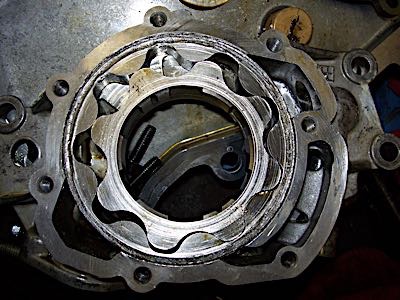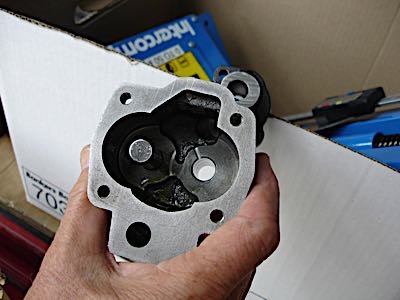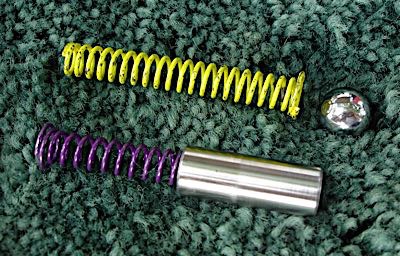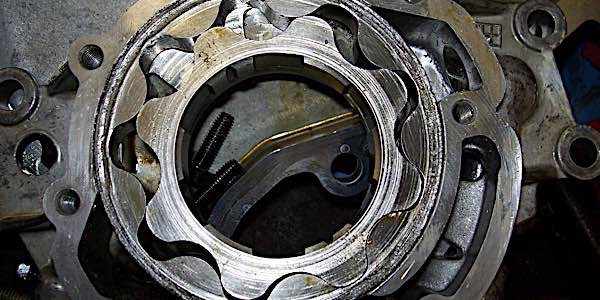
Most engine builders appreciate how important good oil pressure is for proper engine lubrication and longevity. They also know that low oil pressure can cause engine noise, bearing failures and customer complaints that result in expensive warranty claims.
Considering how important oil pressure is for all of these reasons, why would anyone take a chance on reusing a high-mileage oil pump when rebuilding an engine?
Old oil pumps are usually worn with sloppy internal clearances and reduced output. Wear between the gears, the gears and the housing, and the gears and the pump cover provide leak paths that can hinder a pump’s ability to generate normal flow and pressure. Pulling the cover off the pump and sanding or grinding it flat can help tighten up the end clearance between the gears and cover, but it won’t do anything to restore clearances between the gears or the gears and the housing.
The pressure relief spring in a used pump can have millions of compression cycles already applied, and if reused, will run a high risk of failure. A broken spring will allow the pressure relief valve to stay open, greatly reducing the flow output of the pump.
Front-mounted pumps, which are driven by the crankshaft, have machined features called “sacrificial nodes” or rings. These features are used to center the pump to the crankshaft at the engine assembly plant. Due to the design, these will become partially deformed by the crankshaft (hence the term sacrificial) during normal engine operation. So, a used oil pump will have these centering features deformed, which will make centering the pumps to the crankshaft very difficult, if not impossible.
A brand-new oil pump is just as important as new bearings, rings, gaskets and timing chains or belts. Most brand name pumps will have the proper clearances out of the box. Even so, it’s always a good idea to disassemble the pump and check internal clearances with a feeler gauge prior to installing the pump to make sure the clearances are correct. If a pump has too much clearance, take it back and get another or try a different brand. Be sure to reinstall the gears and rotors just as they were removed from the pump. Some internal pump components are not symmetrical, and if installed incorrectly, will lock up when the cover screws are torqued to the proper specification.
Something else to keep in mind with respect to new pumps is that disassembling the pump will void the factory warranty!

OIL PUMP UPGRADES
For a performance engine build, upgrading to some type of performance pump is usually a good idea. This might include a high-volume pump and/or a billet pump for added strength and durability.
Many engines don’t need a high-volume pump because a stock pump will usually generate enough flow and pressure, but there are exceptions. Engines built with looser bearing clearances, piston oilers and/or extra oil lines for upper valvetrain roller rockers or shaft rockers will require a higher volume pump. The same goes for late-model production engines that have cylinder deactivation and/or variable valve timing. They also require higher-flow oil pumps.
Don’t confuse high volume with high pressure. High pressure just means the pump’s relief valve has a stiffer spring that requires higher system pressure to operate. Once the pressure is obtained, some of the output oil flow will be rerouted back to the inlet of the oil pump.
Most engines only need about 10 psi (or less) of oil pressure for every 1,000 RPM, and many engines can get by with as little as 5 to 7 psi per 1,000 RPM.
Oil pumps can use quite a bit of power — as much as 2.5 to 5 percent of the engine’s output — especially at higher engine speeds. That’s quite a power drain, so some late-model engines are now equipped with energy-saving variable displacement oil pumps. A conventional, fixed-displacement oil pump churns out the same volume of oil regardless of how much the engine actually needs. Its output is directly proportional to engine RPM and increases with speed.
By comparison, a variable displacement pump has a vaned rotor mounted on a crankshaft-driven eccentric. It works much like a variable displacement A/C compressor. The vanes rotate and sweep oil from the inlet side to the outlet side. By changing the relative position of the eccentric inside the rotor, or by rotating the outer housing, the relative volume on the inlet and outlet sides of the rotor can be changed to vary the pump’s output. The pump may be spring-loaded to vary pressure, or it can be controlled by the engine computer via an external solenoid. The latter uses a pulse-width modulated signal to fine-tune the pump’s output.
The aluminum or stamped steel covers on some OEM front-mounted oil pumps experience quite a bit of flex under pressure. This can cause oil pressure to fluctuate or even drop at higher engine speeds. Aftermarket replacement pumps for many of these applications have more rigid cast iron covers to improve pressure tightness and priming.
IF OIL PRESSURE IS LOW
If a customer complains that the engine you built for him is not developing good oil pressure, any of the following could be a contributing factor:
- You cut corners and reused a worn, high-mileage pump — big mistake! Now you’ll have to replace the pump at your own expense!
- You installed a new pump, but did not check its internal clearances to make sure it was within acceptable tolerances. That’s partially your fault and partially the fault of the pump supplier. You’ll know better next time!
- Not all the parts were installed. Case in point: GM LS engines have two oil galley plugs — one under the front timing cover and the other under the rear. Forgetting either one or installing the barbell backwards (O-ring seal goes to the outside) will result in low oil pressure.
- The oil pump has a pressure relief valve that is leaking or stuck open. The underlying cause might be a weak or broken pressure relief valve spring, or more likely, debris in the relief valve that prevents it from closing.
One oil pump supplier told us about a problem he’s seen with various spin-on oil filters causing a loss of oil pressure with new oil pumps.
When the filter is installed, any loose debris that is on the outlet side of the filter will be pushed into the engine and will eventually end up back in the oil pan where it will be sucked into the oil pump. Remember, oil pumps run on unfiltered oil. The mesh screen on the pump pickup tube is not fine enough to stop debris that is smaller than the holes between the wires in the screen.
When the debris enters the pump, some of it may be pushed out through the pressure relief valve. It only takes a tiny bit of debris to jam the relief valve open or prevent it from fully closing, causing a loss of oil pressure to the engine.
If you have a new oil pump that isn’t developing normal oil pressure in an engine, remove and disassemble the pump to inspect the pressure relief valve. If the valve contains any debris, you either have a faulty oil filter that is shedding debris into the oil supply or there are contaminants in the oil from another source.
To prevent filter-related contamination, always inspect the inside of a new oil filter BEFORE it is installed. Turn the filter upside down and bang it on your work bench to dislodge any loose debris that might be inside or use pressurized air to blow it out. An ounce of prevention can prevent a lot of headaches down the road. If you have installed a new oil pump and the pressure is still low, these could be the possible problems:
- Oil leaks in any part of the pressurized oil system (oil filter, oil pump to block mounting, oil galleys, etc.). Most factory crankcase-mounted oil pumps do not have a gasket between the pump and block. This junction can leak oil if the mating surfaces are not perfectly flat.
- Defective oil-pressure-sending unit or oil pressure gauge. Many so-called “bad” oil pumps are replaced unnecessarily because the real problem is a bad sending unit or gauge. Check oil pressure directly at the sending unit port on the block with an accurate gauge to confirm oil pressure. If the reading is good, the problem is a bad sending unit or gauge, not a bad pump.
- The oil pump is having problems sucking enough oil through the pickup screen and inlet tube. This type of problem will be worse when the engine is cold, and it may be due to oil that is too thick for the application or a pickup screen that has too fine of a mesh that is creating a restriction.
- If oil pressure is dropping off at higher engine speeds in a racing application, the diameter of the pickup tube may be too small for the volume of oil that the pump is attempting to pull from the pan. Switching to a pump with a larger pickup tube may be necessary.
- Sometimes a low oil pressure problem isn’t an oil pump or internal leak problem, but a combination of loose bearing clearances and the wrong oil.

PUMP REPLACEMENT AND PRIMING
Crankcase-mounted oil pumps are usually self-priming because they are submerged in oil inside the pan, but front-mounted pumps are mounted high and dry and typically take longer to self-prime. Both types of pumps should be presoaked in oil before they are installed. Equally important is pressure priming the engine’s oil system prior to its first start-up.
Front-mounted pumps also require carefully centering the pump on the crankshaft before tightening the pump’s mounting bolts to the block. If the pump is off-center, even slightly, it may bind up and fail when the engine is cranked or started.
One way to center a front-mounted oil pump is to install the pump on the block with the mounting bolts finger tight then crank the engine over several times so the pump can center itself on the crank. The pump-mounting bolts can then be tightened to final specifications.
Another method for centering the pump to the crankshaft is to stand the engine block up on end. This will center the crank in its main bores. The front-mounted pump can then be mounted and centered using a feeler gauge before tightening down the bolts.
Finally, many experts warn against reusing high-mileage oil pickup tubes and screens. Why? Because they are difficult to clean internally and there may be debris left inside. In addition, varnish buildup on the wire mesh reduces the effective open area of the pickup, which will impact the amount of oil flow through the wire mesh. A varnish coating of .005˝ can reduce the open area by 25%.














